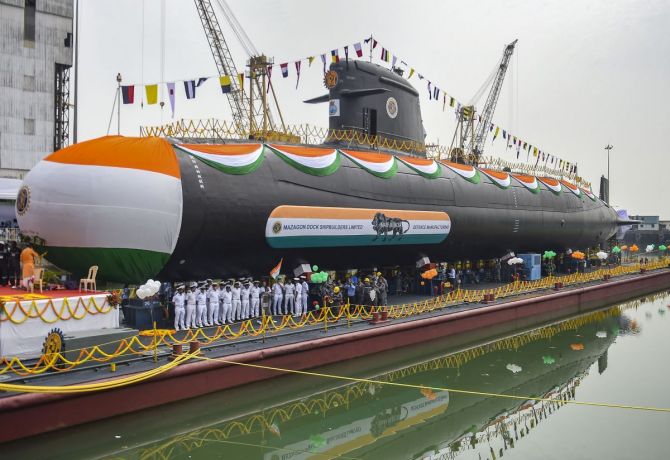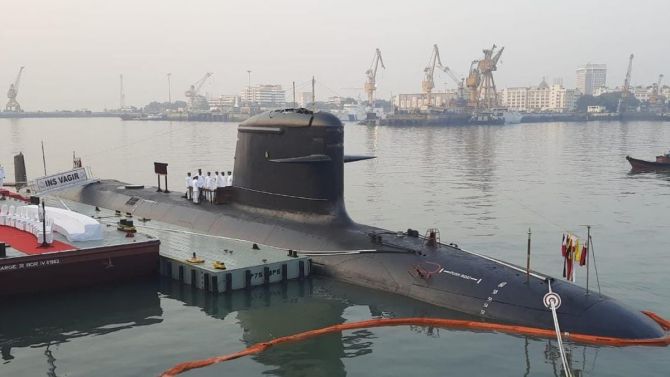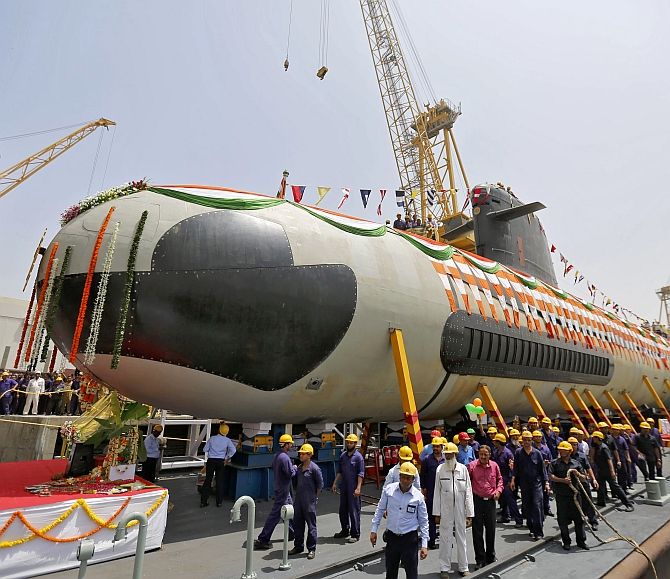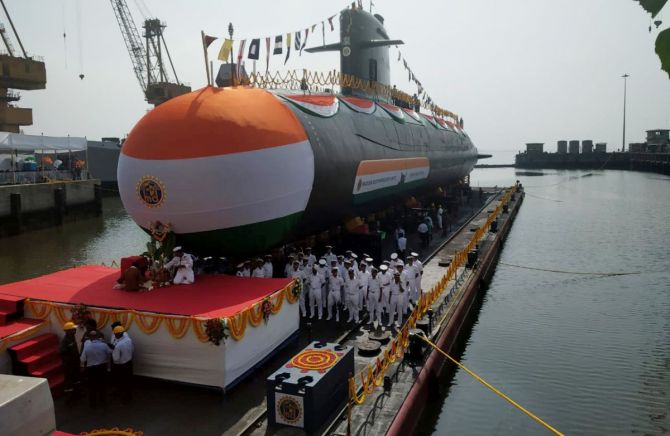The status of the current submarine force level is alarming and we need to address the threat perceptions expeditiously.
Critical decisions pertaining to national security cannot be delayed any further due to the rapidly changing maritime threat perceptions and growing strategic importance of the Indian Ocean region, asserts Commodore Venugopal Menon (retd).

Submarines are vital assets in the maritime domain which are capable of conducting a vast array of missions including Anti-Surface and Anti-Submarine Warfare, Intelligence Gathering, Mine Laying, Land Attacks, Special Forces/Clandestine Operations.
Advanced Navies also deploy nuclear attack submarines (SSN) to provide anti-submarine protection to a formation of surface ships like the Carrier Strike Group.
Further, nuclear submarines provide the most reliable leg of the nuclear triad which assures second strike capability.
Basically, there are two types of submarines -- Conventional and Nuclear, classified as per their mode of propulsion.
Conventional Submarines
A Conventional Submarine is propelled by diesel electric engines on the surface and by electric motors powered by batteries whilst submerged.
These batteries are charged by diesel generators.
The air intake for the diesel generator is facilitated by the snorkel which exposes the snort mast when propelling close to the sea surface.
Thus, the conventional submarines are restricted in submerged endurance due to their battery capacity.
Over the years, the improved efficiency of diesel engines, better batteries and power conserving motors have attempted to limit the constraints and improved the indiscretion rate which is the total time the submarine is exposed vis-a-vis the total time it is dived in a 24h cycle.
The challenge to overcome limitations on endurance, speed and concealment have constantly driven innovation in submarine propulsion technologies to design a system which would not require external air to run the diesel generator which led to the development of Air Independent Propulsion (AIP).

AIP Systems: Development and types
Air Independent Propulsion is any marine propulsion technology which allows a non-nuclear submarine to operate without access to atmospheric oxygen (by surfacing or using a snorkel).
AIP is usually implemented as an auxiliary source with the traditional diesel engine handling surface propulsion.
It does not provide the endurance or power to replace atmospheric dependent propulsion but allows for longer underwater endurance than a conventionally propelled submarine.
AIP is a one shot affair giving conventional submarines enhanced endurance at low speeds for use in specific deployment areas.
Once the AIP endurance is exhausted, the submarine reverts to the conventional mode until the boat' s AIP system is recharged in harbor.
During the 1980s, the leading European Submarine builders developed different types of AIP systems viz Stirling engines, fuel cell system, MESMA (Moduled Energie Sous Marin Autonome) etc.
All these systems are proven and are operational in many navies. Sweden, Japan and China have used Stirling engines.
The French are moving away from the MESMA to fuel cell systems which are used by Spain, South Korea, Germany to name a few.
Lithium Ion Batteries
Another boost to submarine propulsion technology emerged with Japan's Taigei class boats which are fitted with Lithium ion batteries replacing the traditional Lead acid batteries.
Advantages of these batteries include increased battery capacity, faster recharge times and higher energy density.
This resulted in enhanced silent operations, better speeds and sprints, longer underwater endurance and significantly greater overall performance when compared with the more conventional submarines.
The use of these batteries also saved weight and complexity of making an AIP system to extend the underwater endurance.
Safety was a major challenge and extensive research was undertaken to obviate the inherent danger posed by hydrogen gas and intense heat that can be released by the batteries in the event of malfunction.
Heat management and safety remain the major concerns of Lithium ion batteries.

Nuclear Submarines
A nuclear submarine is powered by a nuclear reactor, but not necessarily nuclear armed.
The former is classified as SSN and the latter as SSBN.
They have considerable performance advantages over conventional boats.
It is completely independent of air, frees the submarine from the need to surface frequently as is necessary for conventional boats.
The large amount of power generated by a nuclear reactor allows nuclear submarines to operate at high speeds for longer periods without surfacing thus contributing significantly to stealth factor.
Comparison of Conventional Vs Nuclear Submarines
Note: Indicative unit costs shown above are of a German Type 214 AIP fitted conventional submarine and a US Virginia class SSN. Cost of a French Barracuda class SSN is much lesser around $1.3 billion. These boats have lesser noise levels as compared to other SSNs.
Having analysed the pros and cons of conventional and nuclear submarines, I would like to critically examine the future of the Indian Navy's submarine acquisition programme.
As per open source information, the following projects are at the planning stages.

Project 75 (India)
The Project 75(I), which is a follow on of the Scorpene class, is a planned class of diesel electric submarines which are to be built for the Indian Navy.
This was part of the Indian Navy's 30 year submarine building plan which is far behind schedule.
Under this project, the navy intends to build six conventional diesel electric submarines in India which will feature advanced capabilities including Air Independent Propulsion (AIP).
The boats would have multifarious roles: ISR (Intelligence Surveillance Reconnaissance), Special Operations, Anti-Ship/Anti-Submarine Warfare and land attack capability.
Although the latest RFP (Request For Proposal) under the Strategic Partnership Model (SPM) was issued by the Government in 2021, there has been little progress due to the inability of the OEMs, who were initially in the fray to comply with the envisaged Qualitative requirements especially on the critical proven 'fuel cell AIP system' and liability clauses in the SPM.
The deadline for response to the RFP was last revised to December 2022.
A decision on the future of the project would be taken in 2023 as per reliable sources.
It may also be pertinent to mention that DRDO has developed an indigenous AIP which has been proved on land, but needs to be proved at sea on a submarine.
The stated plan is to retrofit the indigenous AIP if proven on the six Kalveri class (Scorpenes) during their refit.
Meanwhile, an agreement has been signed by the DRDO and the Naval Group, France to cooperate on the integration of the DRDO AIP with the Scorpenes.
However, it still remains unclear whether the indigenous AIP would form part of the Project 75(I) package.
Another option for the Indian Navy would be to examine the conventional diesel electric variant of the Barracuda class (Shortfin Barracuda class with AIP, the Naval Group, France).
It may require modifications in the SPM model and qualitative requirements.
In another development and as per unconfirmed reports, HDW Germany has also proposed its Dolphin Class submarines to bid for Project 75 (I).
These boats would be equipped with a proven fuel cell AIP system.
Since the options have opened up which includes Nevantia Spain as well, it would make it easier for the Indian Navy to expedite the decision making on Project 75 (I) in 2023.
Project 76
The Naval Design Bureau (DND) is also working on developing an indigenous diesel electric submarine with AIP as an inhouse project.
As per available inputs (unverified) the design of the submarine would be ready by 2024.

SSN Programme
The Indian Navy aims to procure/construct six nuclear powered submarines under Project 75A based on government approval in 2015.
This project will be under the Directorate of Naval Design and built in India at the Ship Building Centre, Vishakhapatnam.
As per the earlier plans, the construction is expected to commence in 2023-2024 and the first boat is expected to enter service in 2032.
The submarines are likely to be powered by a miniature pressurised water reactor, which will be designed and built by BARC at the Indira Gandhi Centre for Atomic Research, Kalpakkam.
The expertise available in construction of SSBNs would be very useful in conceptualising our indigenous SSN programme.
SSBN Programme
The Arihant class of nuclear powered ballistic submarines are classified as strategic strike nuclear submarines to complete the nuclear triad.
The first of the four planned submarines is operational, the second is expected to be commissioned in 2023, the third is being fitted out and the fourth is expected to be launched in 2024.
The first two boats are of 6000T and the last two would be of 7000T.
These boats are envisaged to be armed with short range K-15 SLBM which will later be upgraded to K4 missiles with an extended range of 3500 km.
Since the subject is highly classified in nature, the author has covered only the basic information available in open sources.
Threat Perceptions
There is no denying the fact that the navy will play a key role in future wars, especially given the fact that China's focus is on maritime power.
We also cannot ignore the increasing impetus given by Pakistan on their submarine acquisition programme.
The Pakistan navy has completed retro fitment of Air Independent Propulsion (AIP) on their three Agosta 90B submarines.
They have also contracted for eight Hangor class diesel electric AIP fitted submarines with China.
This class is a modified derivative of Type 039B submarines, a follow on of 039A (NATO named Yuan class) operated by the PLA Navy.
Four submarines are to be built in China by the China Shipbuilding Trading Company and the remaining four are to be built in Pakistan by Karachi Shipyard and Engineering Works.
The first four submarines are expected to enter service in 2023 with all eight submarines scheduled to be delivered by 2028.
Needless to say that an inventory of 11 AIP fitted submarines is a major concern for India and would affect the balance of power in the maritime domain.
Prioritisation of Acquisition Plans
It is crucial that the Indian Navy prioritise its acquisition plans based on the risk assessment of the region.
Given the limited funds for modernisation, we need to focus more on sea-denial capabilities, which is cost effective.
Submarines are one of the most effective tools for sea denial.
They are the means to harrying and tiring the enemy.
Their stealth capabilities make them hard to detect in the open seas and are the best platforms for Anti Submarine Warfare (ASW).
Sea Denial Role during Operations: An Indian Context
India-Pakistan Stand-off
Pakistan has structured their navy based on the concept of sea denial with increasing focus on submarines.
They are likely to deploy their boats for surveillance, offensive mine laying, mid ocean missions for interdicting our surface ships and commercial shipping carrying vital cargo.
Their AIP fitted submarines would give enhanced under water endurance of 14-21 days.
This is a factor which has to be given due consideration at the planning level.
India-China Stand-off: Indian Ocean Region
The India-China stand-off spilling over to maritime domain cannot be ruled out in a total war.
I am of the view that considering the distance, logistics, sustenance levels and the threat factor, it is unlikely that the PLA Navy would deploy their surface forces in the Indian ocean region.
It will be prudent for the PLA Navy not to risk such exposure even with their Carrier Strike Group.
Hence, the most effective platform for this task would be their submarines.
In this scenario, conventional boats can be ruled out due to limitations in endurance.
That narrows down the choice to nuclear submarines -- SSBNs or the SSNs.
The former are meant for strategic deterrence and follows the bastion deployment pattern which restricts their positioning, in all probability, to South China Sea.
Hence, from the PLA Navy's perspective, the ideal choice would be to deploy SSNs in the Indian Ocean, tasked for offensive roles and to protect their vital cargo and energy flow in transit.
Although these boats would have an unlimited endurance at station, their transit from the South China Sea to the Indian Ocean undetected would be a major challenge.
A conventional submarine with AIP would be the best bet to counter the PLA Navy SSN.
Advanced AIP fitted submarines have improved stealth features with negligible radiated noise as compared to a nuclear submarine with large reduction gears and noisy pumps which results in much larger radiated noise levels.
Another advantage is that AIP fitted submarines with electro catalytic fuel cells or the high energy Lithium batteries can operate at an ultra quiet state for nearly three weeks (German Type 212) without surfacing or snorkeling.
Indigenous Expertise in Submarine Construction
The nation has made huge investments and developed two submarine building lines.
The conventional submarines are being built by Mazagaon Docks at Mumbai.
Initially, it built two SSK Type 209 submarines with the assistance of Thyssen Krupp Marine Systems of Germany and are now building six Scorpene class with assistance of the Naval Group of France.
The nuclear submarines (SSBN) are being constructed by the Submarine Building Centre along with L&T, DRDO and the navy.
I am of the view that conventional submarines should continue to be built by Mazagaon Docks and nuclear-powered boats by the Submarine Building Centre.
This will ensure that the nation will retain the expertise gained in construction of conventional and nuclear submarines which have been set up with huge investments, both in development and expertise of skilled work force and infrastructure.
Concurrently, we need to improve the efficiency of our shipyards, shorten the time line for construction of platforms and improve the industrial support by integration of public and private sector expertise in our shipbuilding programme.

Way Ahead
The establishment at New Delhi cannot afford to view the critical deficiency in submarine force levels lightly.
There is an urgent need to expedite and revive the long term submarine building plans under Projects 75(I) and 76 in a time bound manner with approvals and budgetary support.
The status of the current submarine force level is alarming and we need to address the threat perceptions expeditiously.
Inordinate delay in decision making would cause the submarine building lines to remain idle at the shipyards, thereby losing the gained expertise and wastage of huge sums invested towards setting up the specialised infrastructure.
The immediate requirement is to focus on construction/acquisition of conventional submarines to make good the critical deficiency in force levels.
Concurrently, the SSN programme need to be progressed based on our threat perceptions, strategic calculus and growing influence in our area of maritime interest.
The future of the SSBN programme would largely depend upon the strategic objectives that the government has envisioned visa vis the rapidly changing geopolitical dimensions.
Critical decisions pertaining to national security cannot be delayed any further due to the rapidly changing maritime threat perceptions and growing strategic importance of the Indian Ocean region.
Commodore Venugopal Menon served in the Indian Navy for 29 years in operational roles, including commands at sea, and training and staff assignments at Naval HQ.
In addition to the staff and war courses in the Indian Navy, he underwent the executive course at the Asia Pacific Centre for Security Studies, Honolulu.
Feature Presentation: Rajesh Alva/Rediff.com









